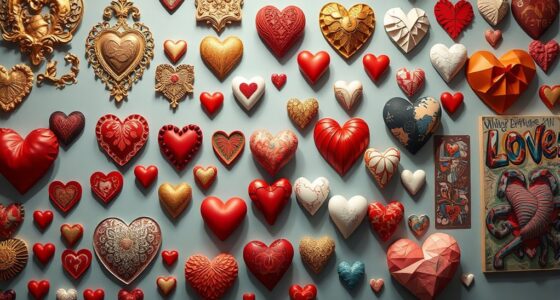When you fold origami, you’re doing more than shaping paper—you’re expressing hopes, wishes, and cultural stories. Symbols like cranes represent peace and resilience, while frogs bring good luck. Each fold can carry meaning, connecting you to traditions passed through generations. By understanding these symbols, your creations gain deeper significance, transforming simple paper folds into powerful messages of hope or protection. Keep exploring, and you’ll discover even more about the rich layers of origami symbolism.
Key Takeaways
- Origami symbols convey cultural messages such as hope, peace, and resilience beyond mere paper folding.
- Recognizing symbolic shapes enhances understanding of traditional values and cultural narratives.
- Folding specific figures like cranes or lotus flowers embodies wishes for healing, purity, and enlightenment.
- Origami acts as a universal language, transmitting meanings like protection, good luck, and spiritual growth.
- Incorporating cultural symbolism into origami elevates it from craft to meaningful cultural expression.

Have you ever wondered what messages or meanings are hidden behind the shapes of origami? When you fold paper into intricate forms, you’re not just creating beautiful objects; you’re also tapping into a world of symbolism and cultural significance. Each origami figure can carry a specific message, representing hopes, wishes, or beliefs that have been passed down through generations. For example, the crane is more than just a paper bird—it’s a symbol of peace and longevity in Japanese culture. Its symbol meanings go beyond the simple act of folding; they embody a deep desire for healing and a wish for a long life. When you craft a crane, you’re participating in a tradition that conveys hope and resilience, especially in times of hardship.
Folding an origami crane symbolizes peace, hope, and resilience across generations and cultures.
Origami isn’t just about aesthetics; it’s a language that communicates across cultures. The shapes you fold often hold specific cultural significance, which can vary from one region to another. In Japan, certain animals or objects are associated with good luck, protection, or spiritual growth. For instance, the frog represents good fortune and safe travels, while the butterfly signifies transformation and renewal. These meanings aren’t arbitrary—they’re rooted in history and folklore, giving each creation a layer of emotional and cultural depth. When you learn about the symbol meanings behind various origami forms, you gain insight into the values and beliefs of the cultures that originated them. It’s a way of connecting with traditions and understanding what a simple fold can symbolize.
Recognizing the cultural significance behind origami shapes also enriches your experience as a creator. It turns a craft into a meaningful act, where each fold becomes a gesture of respect or hope. For example, folding a lotus flower might symbolize purity and enlightenment in some traditions, while a samurai helmet could represent strength and protection. Knowing these meanings adds intention to your folding, transforming it from a mere hobby into a form of expression. As you become more familiar with the symbolism, you’ll see how different shapes serve as messages—whether for celebrating a new beginning, commemorating a loved one, or wishing someone well. Additionally, understanding the size limitations of tiny houses can inspire you to incorporate more meaningful and culturally significant symbols into your origami creations, making them even more special.
In essence, origami is more than just folding paper; it’s a language of symbols that carries cultural significance. Your creations can serve as tokens of good wishes, symbols of resilience, or expressions of cultural identity. Every fold you make connects you to centuries of tradition, allowing you to communicate without words. So next time you fold an origami figure, remember that it’s not just paper—it’s a vessel of meaning, carrying messages woven into its very shape.
Frequently Asked Questions
Can Origami Symbols Be Used for Spiritual or Cultural Rituals?
You might wonder if origami symbols serve a purpose beyond art, such as in spiritual or cultural rituals. They often hold ritualistic symbolism, representing wishes, blessings, or protection. Their cultural significance varies across traditions, where folding techniques and symbols convey deeper meanings. By incorporating origami into rituals, you connect with cultural heritage, expressing respect and hope through these meaningful paper creations.
Are There Specific Symbols Associated With Different Origami Animals?
You might wonder if specific origami animals have unique symbol meanings. Many origami animals represent different aspects of animal symbolism, like cranes symbolizing peace and hope or frogs representing good luck. These symbols often carry cultural significance, especially in Japanese traditions. When folding these animals, you actively create more than a paper figure—you’re embodying the deeper meanings and symbolism associated with each animal, making your craft meaningful and culturally rich.
How Do Origami Symbols Influence Modern Design and Architecture?
You might think origami symbols are just decorative, but they actually influence modern design and architecture through folding techniques and symbolic aesthetics. Investigating the theory, you see how these symbols inspire innovative structures that mimic folded paper’s elegance and efficiency. Architects incorporate these concepts to create dynamic, functional spaces, blending tradition with modernity. This interplay of symbolism and technique pushes boundaries, demonstrating how origami’s visual language shapes contemporary design.
Can Origami Symbols Be Incorporated Into Digital or Virtual Art?
You can definitely incorporate origami symbols into digital or virtual art through digital integration. By using virtual symbolism, you add depth and meaning to your creations, reflecting the elegance of folded paper. Digital tools enable you to animate, manipulate, and seamlessly blend origami-inspired designs into virtual environments, making your artwork more dynamic and interactive. This fusion of traditional symbolism with modern technology opens up exciting new possibilities for creative expression.
What Are the Historical Origins of Using Symbols in Origami Practices?
Imagine ancient hands folding delicate paper into shapes that whisper stories; that’s where symbol origins in origami begin. You discover that cultural symbolism deeply influences these practices, stretching back centuries in Japan and beyond. These symbols, woven into each fold, connect you to a tradition where every crease embodies meaning, history, and spirituality. You carry this legacy forward, blending art and symbolism into a timeless dance of paper and culture.
Conclusion
As you fold these symbols, you’re weaving a tapestry of meaning on your paper canvas. Each crease is a whisper of tradition, guiding your hands like a gentle breeze shaping a delicate sculpture. With every fold, you breathe life into symbols that dance between art and story, turning simple paper into a universe of shared secrets. So, keep folding—because in your hands, paper becomes a vessel for stories that soar beyond the surface.











